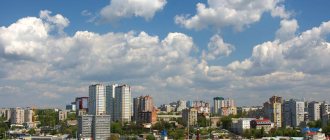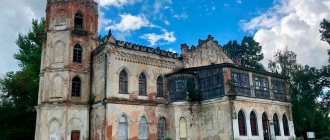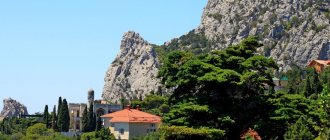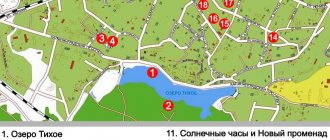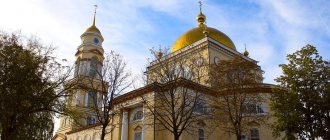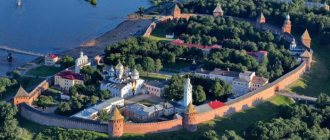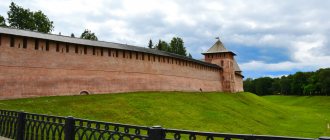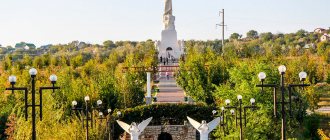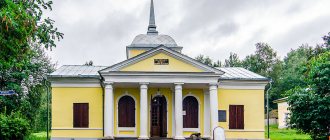Countries > Russia
Rostov the Great has an amazing history: it experienced its heyday several centuries ago, when it had significant political and religious influence. However, now it is a small city in the Yaroslavl region. The heyday left unique architectural monuments that have survived to this day. Most of them are concentrated on the territory of the Kremlin, and mainly they attract tourists to the Golden Ring. But besides them, there are several more interesting places to see. More details in this post.
- Story
- Attractions
- Rostov Kremlin
- Assumption Cathedral
- Hodegetria Church
- Metropolitan Garden
- Rostov enamel
- Church of the Savior at Torg
- Excursions
- Lake Nero
- Neighborhood
- Spaso-Yakovlevsky Dimitriev Monastery
- Church of St. John the Evangelist on Ishna
- Map
- General impressions
Story
Now Rostov is primarily a city in the south of Russia, but it was Rostov in the Yaroslavl region that appeared nine centuries earlier and was once very important.
The heyday dates primarily from the 11th to 13th centuries, when it was the center of the Rostov-Suzdal principality. It was the administrative and religious center of the region. However, later Moscow acquired greater strategic influence, which subsequently deprived the principality of political independence and left Rostov only with important religious powers. But then the main diocese was moved to Yaroslavl, depriving it of this function. Then it becomes a shopping center with the largest fair in the area.
Since the 19th century, a real decline begins: gradually, only the architecture remains of its former greatness, and it becomes a small county town. Despite the fact that now it is practically not developing, Rostov the Great has preserved an impressive historical heritage, attracting many tourists traveling along the Golden Ring.
Interesting excursions in Rostov-on-Don
Rostov-on-Don is a great city for both a one-day walk and a full-fledged trip. Both in the “southern capital” itself and in its surroundings there are a lot of interesting places - natural beauties, cultural monuments, historical cities and settlements. It’s more interesting to get to know them in the company of a professional guide—an expert on the destination.
Experienced travelers, when choosing where to go in Rostov-on-Don in 1 day, recommend starting your acquaintance with the historical part of the city. The ancient quarters invite you to take a stroll - Rostov can be called an open-air museum of architecture of the last century. Ancient merchant mansions, magnificent facades, fountains and the quiet provincial charm of narrow streets, not a single detail of which will escape your attention - after all, you are walking with a guide.
When all the most interesting things in Rostov have been explored, you can take a ride around its surroundings. Just half an hour on the road - and you are walking through one of the oldest cities in the south of Russia, thousand-year-old Azov . Or visit the ancient settlement of Tanais , where ruins of buildings built by the ancient Greeks have been preserved. Another cool walking destination is Loga Landscape Park . You can walk along its charming alleys for several hours and then dine on Don delicacies at a local restaurant.
All excursions from Rostov from Turister.Ru
Main attractions
Rostov Kremlin
The Rostov Kremlin was built in the 17th century according to the design of Iona Sysoevich, an associate of Nikon. Trying to create an ideal place, close to the image of paradise, Jonah created several projects in his metropolis, according to which famous monasteries were built in Borisoglebsk, Uglich and Rostov. After the transfer of the metropolis to Yaroslavl, the decline also affected the Kremlin: its buildings were severely destroyed. Only at the beginning of the 20th century large-scale restoration work began to be carried out.
Despite the large number of people, there is an incredibly calm atmosphere here, and it is easy to mentally transport yourself back several eras.
The Kremlin has more than once been included in the list of symbols of Russia - being an expressive example of the flowering of architecture of the 17th century, in the general view it is apparently also an example of typical “Russian architecture”.
Red Chamber
Famous films were filmed in the Rostov Kremlin: “Ivan Vasilyevich Changes His Profession”, “Boris Godunov”, “The Incredible Adventures of Italians in Russia” and others. Almost all of them took place in one way or another around the Red Chamber, a civil building from the 17th century. Her expressive “Russian” style is perfect for historical settings. Now there is a restaurant inside, the interiors of which are stylized as antique.
Cathedral Square, 8
Working hours: 10:00-17:00
Entrance: 70 rubles, with all exhibitions and expositions - 750 rubles.
Assumption Cathedral
Once the cathedral was the main one for the entire Yaroslavl diocese, but after the transfer of the metropolis to Yaroslavl it began to fall into decay. Restoration in the 1980s and 90s saved it from destruction, and its original appearance was restored.
The modern building was built in the 16th century on the site of older temples. In the Assumption Cathedral you can see how the interiors usually look without restoration.
Sights of Rostov Veliky
Sights of Rostov the Great. The most important and interesting sights of Rostov the Great - photos and videos, descriptions and reviews, location, websites.
- Last minute tours
to Russia
- Rostov Veliky
the very bestNero
Rostov Veliky
According to legend, the name of Lake Nero came about as follows: one eccentric man was looking for Rostov in these parts. He wandered for a long time and was completely exhausted when he suddenly saw the city. But the man doubted and was about to say: “This is not Rostov,” when he was immediately struck by an arrow. In general, he only managed to say: “This is not Ro.”
- fabulous
Rostov Veliky, Kremlin
the very best
Rostov Kremlin
fabulous
2 reviews
Rostov Veliky, Kremlin
The “calling card” of tourist Rostov is the Kremlin with its five churches, the Assumption Cathedral and a complex of residential buildings, surrounded by powerful fortress walls. According to its original purpose, the Kremlin was the residence of the bishops of the Rostov-Yaroslavl diocese.
- fabulous
Rostov Veliky, st. Engelsa, 44
the very best
Spaso-Yakovlevsky Monastery
fabulous
3 reviews
Rostov Veliky, st. Engelsa, 44
In addition to the main attraction of Rostov the Great, the city has many places worth visiting. One of these is the Spaso-Yakovlevsky Monastery. Here in the Conception Cathedral the relics of Demetrius of Rostov and St. James are kept.
- Rostov Veliky, st. Zhelyabovskaya, 32
Avraamiev-Epiphany Monastery
Rostov Veliky, st.
Zhelyabovskaya, 32 Epiphany Avraamiev Monastery is one of the oldest on the territory of modern Rostov the Great. The monastery stands on the shores of Lake Nero and looks very picturesque from the water. It was founded at the end of the 11th or beginning of the 12th century by the famous saint, St. Abraham of Rostov. - Rostov Veliky, Sovetskaya square, 14
Mother of God Nativity Monastery of Rostov the Great
Rostov Velikiy, Sovetskaya Sq., 14
We mostly have to talk about the Mother of God Nativity Monastery in the past tense. The first convent for women in Rostov the Great was founded in 1390 by Archbishop and Saint Theodore, nephew and comrade-in-arms of Sergius of Radonezh. - not bad
Yaroslavl region, pos. Borisoglebsky
Boris and Gleb Monastery
not bad
2 reviewsYaroslavl region, pos. Borisoglebsky
The monastery near Rostov was founded on a picturesque hill surrounded by the meanders of the Ustye River, in 1363, during the time of Dmitry Donskoy, with the blessing of Sergius of Radonezh, who showed the hermits Theodore and Paul the place to build a temple in the name of the holy Russian passion-bearers, princes Boris and Gleb.
- Rostov, st. Moravskogo, 6
Gymnasium named after A. L. Kekina
Rostov, st.
Moravskogo, 6 The men's gymnasium in Rostov the Great - the oldest and largest educational institution in the entire Yaroslavl region - was opened in 1910. A. L. Kekin was born in Rostov, but went to St. Petersburg, where he became a successful merchant. - Rostov, st. Dostoevsky, 39
Museum "Lukova Sloboda"
Rostov, st.
Dostoevsky, 39 A wooden building with a noticeable sign, stylized as a Slavic hut both outside and inside, is perhaps one of the most unusual places in Rostov the Great. The Lukova Sloboda Museum is unique because it is designed to satisfy not only the need for knowledge, but also hunger. - Rostov Veliky, Borisoglebskoe highway, 3
Enamel Museum and Gallery
Rostov Veliky, Borisoglebskoe highway, 3
Rostov craftsmen have long been famous for products with enamel (the ancient Russian name for enamel). The art of decorating metal products with enamel came from Byzantium in the 10th century. and reached its heyday in Rus' in the 16th-17th centuries. - Rostov Veliky, st. Leninskaya, 20
Museum "The Frog Princess"
Rostov Veliky, st.
Leninskaya, 20 The Frog Princess is one of the most mysterious and beloved characters in Russian fairy tales. The ancient city of Rostov the Great invites you to visit a fun interactive museum dedicated to this creature. They don't promise to turn into princesses, but it will be interesting - that's for sure. - Rostov Veliky, Varnitsy village (p/o Ishnya village)
Trinity-Sergius Varnitsky Monastery
Rostov the Great, Varnitsy village (p/o Ishnya village)
Rostov the Great, being a significant part of the Golden Ring of Russia, is rich in religious attractions and historical monuments. Because of this, the Trinity-Sergius Varnitsky Monastery is easy to miss - it’s a new build, and it’s also located a few kilometers from the city. - Rostov Veliky, st. Karla Marksa, 25 a
Church of the Ascension of the Lord in Rostov the Great
Rostov Veliky, st.
Karl Marx, 25 a Church of the Ascension of the Lord (Church of Isidore the Blessed on the Ramparts) is one of the oldest buildings in Rostov. The emergence of the church is associated with the name of St. Isidora Tverdislova. This saint chose the city of Rostov for his feat of foolishness for Christ. - Rostov the Great, Kremlin
Church of St. John the Evangelist in Rostov the Great
Rostov the Great, Kremlin
The Church of St. John the Evangelist is part of the architectural complex of the Rostov Kremlin, towering above its western gate. It was built last, in 1683, when the image of the Bishop's House, which is now called the Kremlin, was completely formed. - Rostov the Great, Kremlin
Church of Hodegetria in Rostov the Great
Rostov the Great, Kremlin
The building in the Naryshkin Baroque style stands out sharply against the background of the ancient Russian architecture of the Rostov Kremlin: the facades are painted with a pattern imitating triangular projections, and an external open balcony stretches along the entire second floor. - Rostov the Great, Kremlin
Church of the Savior on Senya
Rostov the Great, Kremlin
Metropolitan Jonah, the founder of the Rostov Kremlin, considered his home church of the Savior on Senya the center of the spiritual life of the entire diocese. It was built in 1675, as indicated by the inscription on the surviving cross. The Church of the Savior on Senya is perfectly visible from Lake Nero.
Rostov the Great is the oldest city of Kievan Rus, one of the eight cities of the Golden Ring of Russia, the cradle of original Russian architecture, the Orthodox capital of the state, the largest pilgrimage and tourist center in the country.
Rostov the Great preserves within its walls the history of a mighty state and the culture of a great people. And along with the original architecture, the city presents the true beauty of Russian nature: deep lakes and birch groves. The historical part of Rostov the Great is concentrated on the western shore of Lake Nero. In the center is the main attraction of the city - the Rostov Kremlin. And from it the streets spread out, heading into the outback of the city.
The historical part of Rostov the Great is concentrated on the western shore of Lake Nero. In the center is the main attraction of the city - the Rostov Kremlin. And from it the streets spread out, heading into the outback of the city. A wide embankment with a boat station winds along the shore. By the way, from the side of the lake, the cityscape of Rostov seems even more impressive.
The Rostov Kremlin covers a fairly large territory. Closer to the embankment there is the Metropolitan's garden and the prince's tower, then behind them are the Church of Gregory the Theologian, the Church of the Savior on Senya and the White Chamber, as well as a complex of outbuildings. The center of the Kremlin is crowned by a large beautiful pond. And at the other end of the metropolitan courtyard stands the golden-domed Assumption Cathedral with a belfry and the Holy Gate. The entire territory of the Kremlin is surrounded by powerful stone walls, which, however, serve a decorative rather than a defensive function. And all because the Kremlin itself was originally planned not as a defensive structure, but as the residence of the metropolitan. Thanks to this, the Rostov Kremlin differs from all others in its special grace and sophistication.
In the 70s The filming of the film “Ivan Vasilyevich Changes His Profession” took place in the Rostov Kremlin. The heroes of the famous film ran in pursuit along long passages, which in the original connected all the buildings of the Kremlin.
The architectural ensemble of the Spaso-Yakovlevsky Monastery rises on the western outskirts of Rostov, also on the shore of the lake. The complex fits perfectly into the local lakeside landscape, and thanks to the harmonious combination of various architectural styles, it creates the feeling of a fairy-tale city. Within the walls of the monastery there is a holy spring of St. James, the water of which is considered healing.
And in the opposite part of the city is the Avraamiev Epiphany Monastery - the oldest Orthodox monastery in Rostov. It is believed that it was founded on the site of the pagan stone idol of Veles in response to the prayers of the hermit Abraham. True, over time, the architectural complex of the monastery has undergone significant changes, and its original structure, including the fortress walls and courtyard, has been lost.
Despite the fact that the main attractions of Rostov the Great are, of course, temples, churches and cathedrals, there are other interesting things in the city. Thus, in Rostov there is a one-of-a-kind Museum of Enamel, displaying the largest collection of works of art in Russia, created using unique technologies by local craftsmen. Otherwise, enamel is called “fire writing,” and Rostov artists mastered it perfectly.
Church of the Savior at Torg
The modern building of the Church of the All-Merciful Savior in Torg was built in the 17th century. Once upon a time it was located between the shopping arcades of Gostiny Dvor, which is why it received such a name. The blue dome is decorated with stars.
Shopping arcades
Like Suzdal or Kostroma, Rostov has its own “Gostiny Dvor” with shopping arcades. This is a typical building for that time in a classical style with arched entrances to each merchant's shop. Together with the church they form a single architectural complex. The rows are still primarily used for trading.
Tolga Church
The Church of the Tolgskaya Icon of the Mother of God is the only city religious institution that continued its work during Soviet times. A neat but elegant temple was built in the 18th century. The relics of John the Merciful are kept inside.
Wiki/Commons
Ascension Church
The ancient Church of the Ascension of the Lord was abandoned for a long time and was plundered several times. Fortunately, the frescoes were preserved, but the unique wooden carved iconostasis was lost.
Museum of Rostov Merchants
In the small mansion, the interiors have been completely recreated and items from merchant life have been preserved. Here you can imagine how provincial merchants lived two centuries ago and get acquainted with the history of the famous Rostov Kekin family.
Leninskaya st., 32
House of Crafts
The House of Crafts contains works of craftsmen engaged in folk crafts and decorative arts. For example, objects made of black-polished ceramics, birch bark and wood carvings. However, this is not a simple exhibition. Here you can take part in master classes and try to learn how to make dolls, products from birch bark or wood. For example, whistle toys, majolica figurines or ceramic pots. Excursions and events dedicated to Russian folklore are regularly organized. The house is located in the very center.
From the website domremesel.com
2nd passage of Tolstoy embankment, 16
Khors Art Gallery
A unique museum, the exhibition of which presents a wide collection of artistic enamel. It contains both ancient works of art and modern art objects by artists from all over Russia. Some of the presented objects can be purchased. In addition to the regular exhibition, exhibitions dedicated to contemporary art and master classes are regularly held for those wishing to master the unusual skill of making objects from enamel.
st. Podozerka, 31
Excursions
Despite its small territory, the history of Rostov the Great is so rich that it will be quite difficult to prepare on your own. If you don’t want to miss anything interesting and learn more about the unusual history of the city, you should book a tour with a local professional guide:
City Park
The main recreational place for residents is the city park. It is located west of the center on the shores of Lake Nero. The green and calm park is perfect for relaxing and walking. Several years ago, its landscape was reconstructed and landscaped, in particular, more recreational and children's areas appeared.
Where to stay in Rostov-on-Don
Rostov-on-Don is a large city; there are hundreds of hotels, apartments and a good selection of hostels for accommodation. An attractive part for tourists is the central area along the right bank of the Don, Bolshaya Sadovaya and Krasnoarmeyskaya streets. Hotels are different: from simple and uncategorized to luxurious new 4-5 stars. Among them are representatives of the Amaks, Mercure, Radisson Blu, and Ramada chains.
One way to find interesting ones is to consider housing with a view of the Don, like the Radisson Blu Hotel Rostov-on-Don or apartments on the river side in the White Angel residential complex. The park options on the shore are pleasant: “Averon”, “Vysoky Bereg”. For hot summers, it is important to have an outdoor pool, since swimming is often prohibited in the Don: for example, “Jardin”, “Weekend”.
- Rostov-on-Don Hotels
- Hostels for Budget Travelers
- Flats and apartments
See also the special review of Tourist. RU:
- Hotels near Rostov-on-Don airport
When booking accommodation on Booking.com, cashback is available: Cashback promotion for Tourist. RU
The ancient city of Azov Photo: © Julia Alisova
Neighborhood
Spaso-Yakovlevsky Dimitriev Monastery
From the lake you can see the ancient Spaso-Yakovlevsky Dimitriev monastery, founded in the 14th century. Most of the surviving buildings were built later, and their architecture is significantly different from the Kremlin - it is more classical and baroque style. The monastery's cathedrals will also be of interest for their ancient frescoes.
Church of St. John the Evangelist on Ishna
Another important attraction is the Church of St. John the Theologian, which is located in the vicinity of Rostov in the Bogoslov area. It was built in 1687 and is a unique wooden monument preserved from that time. You can see many carved elements in the temple. Inside there is a copy of the Royal Doors from 1562.
village of Bogoslov
Working hours: 10:00-17:00
Entrance: 80 rub.
